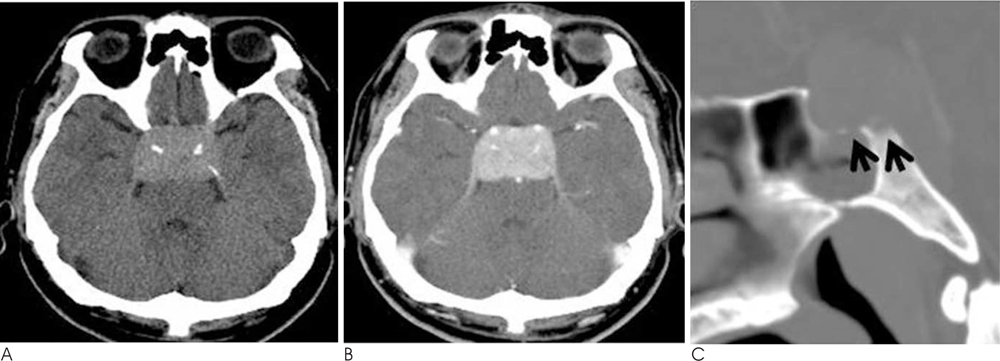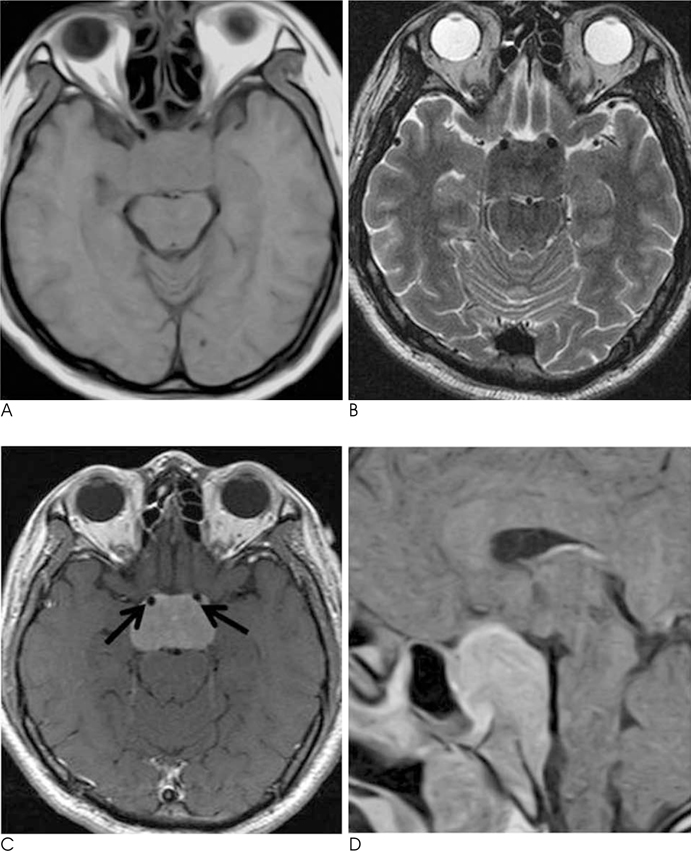J Korean Soc Radiol.
2011 Apr;64(4):303-307. 10.3348/jksr.2011.64.4.303.
Inflammatory Pseudotumor of the Pituitary Gland Mimicking a Pituitary Adenoma: A Case Report
- Affiliations
-
- 1Department of Radiology, Eulji University Hospital, Daejeon, Korea. midosyu@eulji.ac.kr
- 2Department of Neurosurgery, Eulji University Hospital, Daejeon, Korea.
- 3Department of Pathology, Eulji University Hospital, Daejeon, Korea.
- KMID: 1443531
- DOI: http://doi.org/10.3348/jksr.2011.64.4.303
Abstract
- A 38-year-old man was admitted to our hospital with diplopia. The patient had a relatively well-defined pituitary mass with high cellularity as well as weaker enhancement on imaging modalities including computed tomography (CT) and magnetic resonance imaging (MRI), than a typical pituitary adenoma. The distinction between a pseudotumor and an invasive neoplasm is very difficult before biopsy. In this case report, we discuss the characteristic imaging features of a fibrosing inflammatory pseudotumor of the pituitary gland.
MeSH Terms
Figure
Reference
-
1. Lee JH, Kim KJ, Chung SW, Choi YC, Lee Ah. A case report of inflammatory pseudotumor involving the clivus : CT and MR findings. Korean J Radiol. 2001; 2:231–234.2. Al-Shraim M, Syro LV, Kovacs K, Estrada H, Uribe H, Al-Gahtany M. Inflammatory pseudotumor of the pituitary gland: case report. Surg Neurol. 2004; 62:264–267.3. Hansen I, Petrossians P, Thiry A, Flandroy P, Gaillard RC, Lovacs K, et al. Extensive inflammatory pseudotumor of the pituitary. J Clin Endocrinol Metab. 2001; 86:4603–4610.4. Murakami K, Muraishi K, Ikeda H, Yoshimoto T. Plasma cell granuloma of the pituitary gland. Surg Neurol. 2001; 56:247–251.5. Choi SY, Yu IK, Han MH, Lee BH, Song CJ, Kim KS. Fibrosing inflammatory pseudotumor of the nasopharynx: MR features and histopathologic correlation. Euro J Radiol. 2009; 72:274–277.6. Mombaerts I, Goldschmeding R, Schlingemann RO, Koornneef L. What is orbital pseudotumor? Surv Ophthalmol. 1996; 41:66–78.7. Swain RS, Tihan T, Horvai AE, Di Vizio D, Loda M, Burger PC, et al. Inflammatory myofibroblastic tumor of the central nervous system and its relationship to inflammatory pseudotumor. Hum Pathol. 2008; 39:410–419.8. Han MH, Chi JG, Kim MS, Chang KH, Kim KH, Yeon KM, et al. Fibrosing inflammatory pseudotumors involving the skull base : MR and CT manifestations with histopathologic comparison. AJNR Am J Neuroradiol. 1996; 17:515–521.9. Seider MJ, Cleary KR, Van Tassel P, Alexanian R, Schantz SP, Frias A, et al. Plasma cell granuloma of the nasal cavity treated by radiation therapy. Cancer. 1991; 67:929–932.10. Char DH, Miller T. Orbital pseudotumor. Fine needle aspiration biopsy and response to therapy. Ophthalmology. 1993; 100:1702–1170.
- Full Text Links
- Actions
-
Cited
- CITED
-
- Close
- Share
- Similar articles
-
- Pituitary Apoplexy due to Pituitary Adenoma Infarction
- Two Cases of Pituitary Hyperplasia Secondary to Primary Hypothyroidism Mimicking Pituitary Tumor
- A Case of Acromegaly Caused by Mixed Gangliocytoma-Adenoma of the Pituitary Gland
- Computed tomography of pituitary apoplexy: report of 2 cases
- Metastasis of Hepatocellular Carcinoma to Pituitary Adenoma: A Case Report




